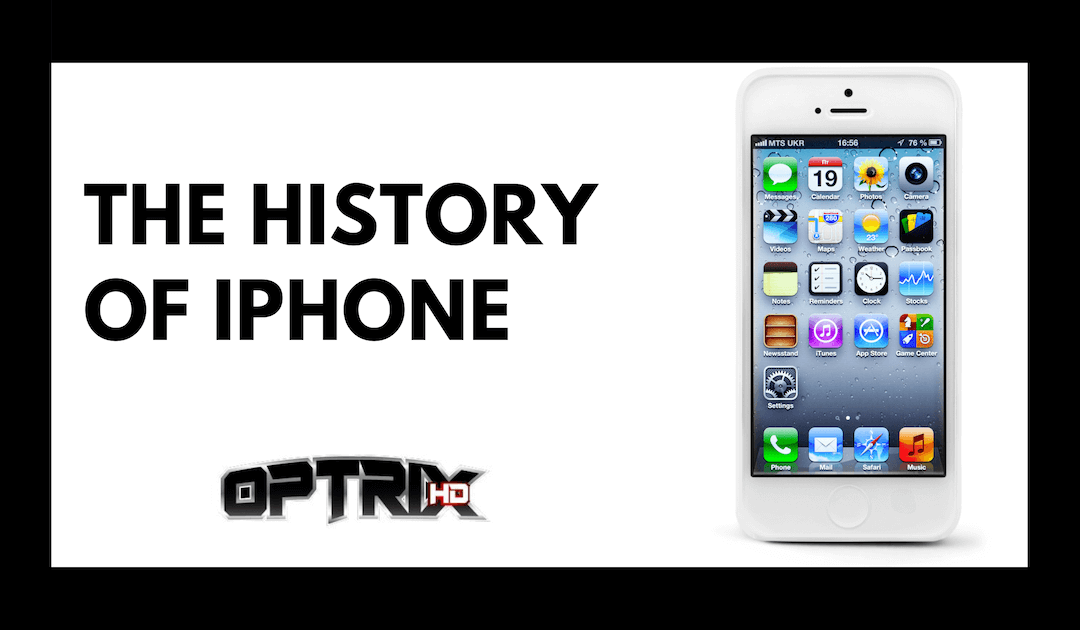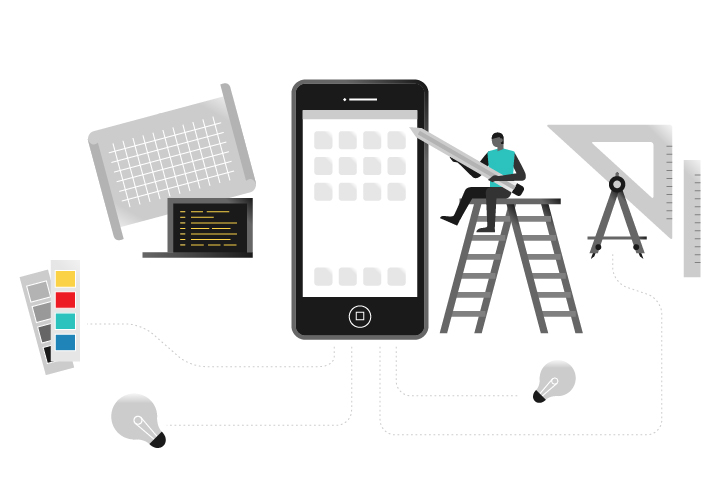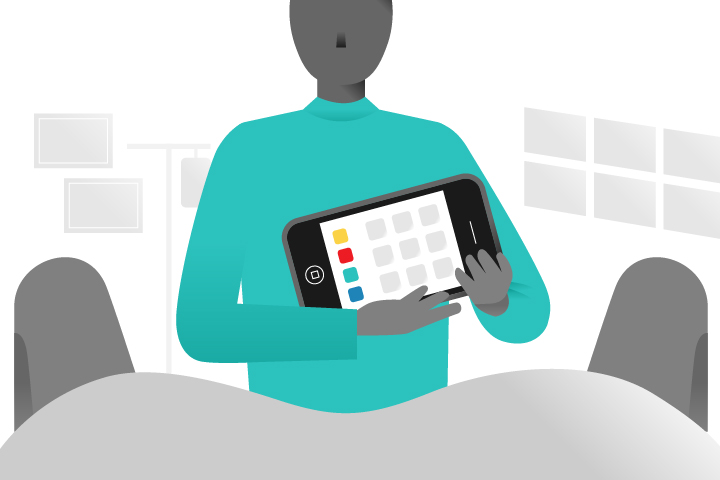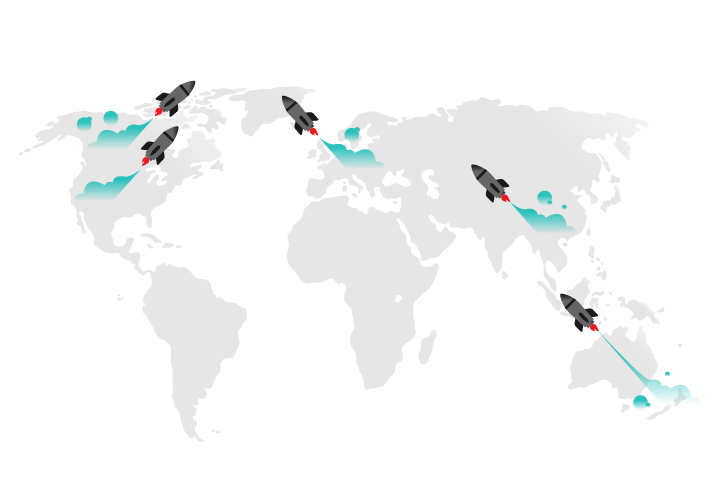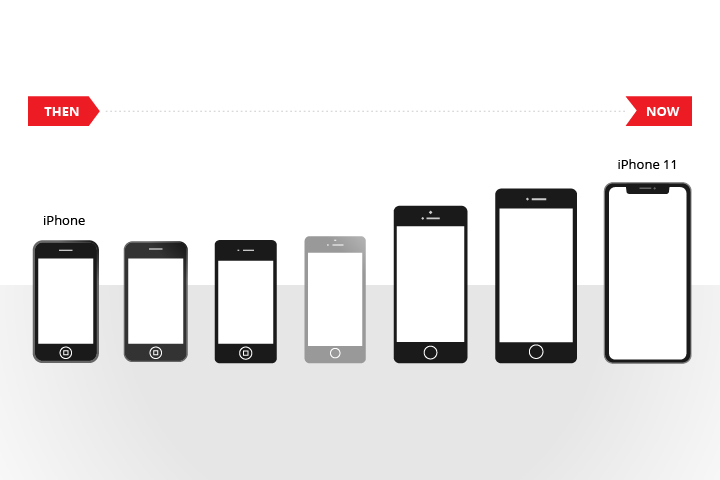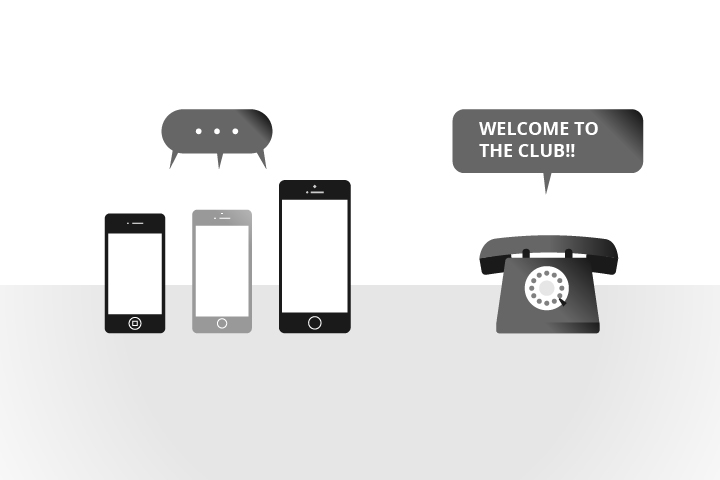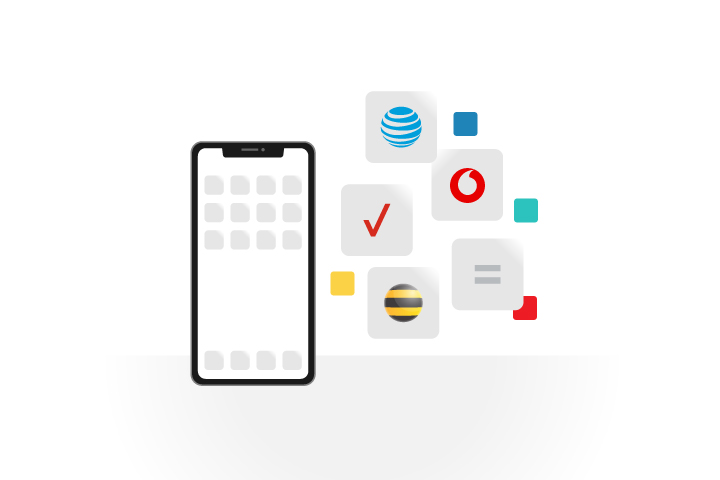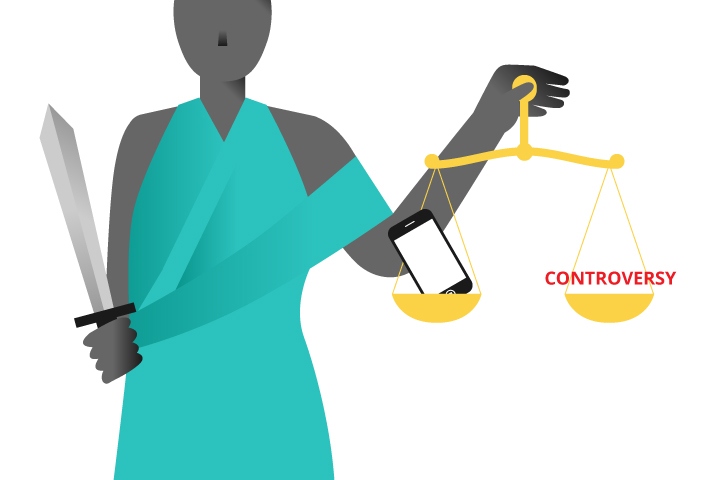Apple Inc. was founded by Steve Jobs and Steve Wozniak on 1st April 1976 and was incorporated on 3rd January 1977. The company only manufactured personal computers for more than 30 years with Apple II, Power Mac, and Macintosh being their top creations.
These computers had a meager market share and made the company struggle. However, fortunes changed on 23rd October 2001 with the introduction of iPod – a music player and later iTunes in 2003.
Apple took its rightful place as a leader in media sales and consumer electronics. On 9th January 2007, Apple launched its first iPhone, and it was received exceptionally well thanks to the success of iPod and iTunes.
The Conceptualization
After some time, the iPod started to fade. This is because the invention of the iPod relied entirely on music. Again no company had invented software that would connect the computer and the iPod.
Also, even though you could sync music automatically, the transfer of the music from the iPod was time-consuming. One significant advantage of the mobile phones over iPod was the additional calling option. This meant that apart from playing music, the phones were convenient for making calls.
The phones did not need the use of hard drives to store music, and instead, used removable memory cards. Phones would threaten the use of iPods, but some consumers still wanted devices invented for a specific purpose.
The mobile phones came with extra features that were also appealing to the users. The extensive use of the new music phones entailed other additional-functional features ideal for the consumers. In a nutshell, mobile phones offered inbuilt features such as cameras, which would affect Apple’s money-making ability.
The Newton MessagePad
This was the first device by Apple computers for the Newton platform, and it was developed in 1993. It entailed an ARM 610 RISC processor and an additional handwriting recognition software. The screen would be used both in landscape and portrait, and it also had a rotating feature from 90 degrees to 270 degrees.
The use was quite easy, and making corrections was also effortless. When it came to drawings and shaping, Newton recognized the user’s attempt to draw specific shapes and helped to perfect the image outcomes automatically.
However, even if the handwriting recognition and shapes were cleaned off for perfection, these features were unreliable. Again the storage of handwritten messages was also required to be rewritten before sending.
It used the AAA batteries, which were later replaced with AA batteries after the release of the Apple Newton MessagePad 110. With time there was the need to improve this device, and this included the improvement of the handwriting recognition system, the processor, and got a more apparent, better, and backlit screen.
Rokr E1 Aka The iTunes Phone
Included a series of Motorola mobile phones and part of the 4LTR line that had been developed before the Motorola mobiles spun out. What made them noticeable to consumers was their support for media player features. Ideally, it would include an inbuilt iPod.
It featured a music player with a similar interface to that of Apple’s iPod music players. Motorola was working in collaboration with Apple to create a very cool device that could also run iTunes. However, this meant that they were to do 100% of what would benefit Apple compromising for their success.
Additionally, Jobs said that the phone was not good enough as it did not meet the AT&T verifications to get to the end-users. Jobs had reached an agreement that AT&T would be the iPhone’s exclusive carriers, and nothing would pass without considering their take.
It was hard for consumers to unlock their devices with any other carriers apart from the ones chosen by Jobs. For this reason, customers were jailbreaking their devices for access to leave their networks. When AT&T realized what was happening, they began to impose charges for going early before the end of their contracts.
Epic Fail
Steve Jobs felt that the collaboration between Apple and Motorola to bring ROKL E1 was a way of compromising for a non-Apple designer. Additionally, this made him unhappy as he viewed it as a way of preventing Apple from designing phones that they would like.
It’s at this moment that Jobs decided to discontinue the project. This included all the support that Motorola was getting from Apple. Jobs viewed that the Rokl E1 was made of cheap plastic design, entailed a mediocre camera, and was limited to only 100 songs compared to the iPod memory storage.
Again it required consumers to buy songs from iTunes. Then use a cable to transfer the same. On the other hand, Jobs failed to highlight the fact that this phone could play iTunes music correctly. It was not long until he was fed up, and he decided to declare the device absolute in September 2006 during the launch.
The Birth Of The iPhone Project: Purple Experience
The iPhone began after the projects were approved in 2004. The aim was to invent a device that was more convenient than the computer. Suitable in the sense that it would be portable and, above all, have several inbuilt features that would make it ideal for all consumers.
The project came with so much testing and failure of the iPhone before the final release. One thing that made Apple invent the iPhone was because it was already known for making Mac computers, and despite having a small market share, the device was excellent.
This project was serious that Jobs instructed that no one from the outside was supposed to add input towards the same. It involved a lot of work, like brainstorming and testing. After the hard work and long nights, in 2006, a design prototype was finalized.
Fingerworks & Model 035
Fingerworks was the idea of having a keyboard with multi-touch options that was majorly helpful to people suffering from RSI. The entire keyboard was multi-touch, and it ensured the conversion of finger movements to create messages.
The available multi-touch keyboard was compatible with Apple laptops. On the other hand, it was almost as thick as a laptop, and when the company attempted to build a touchscreen device, it led to the invention of an iPhone.
The Bake Off
In the beginning, Apple had no experience producing phones. To address the development risk associated with the steep learning curve, the project team created two phone projects, code-named P1 and P2.
The P1 project was for the iPod phone while P2 was for the experimental hybrid of multi-touch technology and Mac software. These two were top-secret projects. The parallel projects ensured that Apple would have a working prototype if one were to fail.
Working The Operating System
Apple DOS was Apple’s first operating system for computers, and it was developed in the late 1970s. The breakthrough came in the early 80s when they developed Mac OS, and the primary idea behind the operating system was providing users with the best possible user experience.
However, Apple faced a lot of challenges along the way, and some of them include stiff competition from Microsoft and implementation issues concerning the use of filesystems.
The Launch
The United States Launching
Steve Jobs was addressing his employees on 28 June 2007, where he declared that each employee would be working full time and part-time employees would receive a free iPhone. On 29 June the same year, people were seen camping outside the company in New York City to buy the iPhone.
The analysis showed that an estimation of 250,000-700,000 iPhones were sold in the first weekend. 95% of these sales of the iPhone were the 8GB models.
The European Launching
The iPhone was launched in Europe on 9 November 2007. This was officially in the United Kingdom and Germany. Again consumers lined up to purchase the anticipated iPhone.
On 1 December, there was the availability of unlocked phones in the market because the first ones were locked, and you were needed to verify the same to unlock. European countries began to receive the iPhone from 6 May 2008 until September 2010, where it was released for the first time in Finland.
Release In Southeast Asia
The iPhone in south Asia was launched in August 2008. Canadians had waited for long until 11 July 2008, when the first iPhone that is iPhone 3G was released. After facing a public backlash, roger wireless released 8GB and 16 GB models and reduced the prices for the same.
Release In New Zealand
The first release was made available through Parallel Import Stores not so long after it was sold in the US. Ideally, releases in New Zealand were made available a few weeks after releases in other nations. However, in November 2011,iPhone 4s was made available by telecom networks and other previous models.
The Launching In Canada
The first iPhone to be launched in Canada was the iPhone 3G. Later the Rogers wireless company released the iPhone 3GS on 19 June 2009, which further had either 16 or 32 GB storage memory.
The Evolution Of iPhone Models
The First iPhone
After years of speculation, hard work, and invention, the first iPhone, iPhone 1 and iPhone 2G were released in the United States on 29 June 2007. Thousands of people were estimated to have waited for the iPhone outside retail shops and other Apple shops. The iPhone upon release was sold for $499 for the 4GB model, and there were many positive reviews towards the same.
Tech Specs
- Original 0.S 1.0
- Samsung 32-bit CPU
- 128 GB RAM
- 4, 8, 16 GB flash memory
- 1400 mAh battery
- 3.5-inch screen display
- 2.0 MP rear camera
- Wi-Fi, Bluetooth, and USB connectivity
iPhone 3G
This was the second generation of the iPhone. It was first introduced on 9 June 2008, in San Francisco, United States, at the Moscone Center.
Tech specs
- 128 MB RAM
- 8, 16 GB flash memory
- 1150 mAh battery
- 3.5 inches’ screen display
iPhone 3GS
It was introduced to the market on June 10, 2009, in San Francisco. This device came with the 32 GB storage option because 16 GB wasn’t enough for the iPhone, especially with the phone’s camera, music, and app’s need for storage.
Tech specs
- 3.15 MP camera
- Available loudspeaker
- Non-removable battery
- 256 MB RAM
- 8, 16, 32 GB memory
iPhone 4
It was first unveiled in San Francisco on June 24, 2010. Approximately over 30 million iPhones were sold in a span of the first three years. However, as expected, Apple still wanted to release the latest make that would be iPhone 4s.
Tech specs
- 5 MP rear camera with available flash
- 2 microphones
- iOS 4 that’s upgradable
- Long-lasting battery
- 16 GB internal memory
iPhone 4s
iPhone 4s was released on October 14, 2011, and offered consumers new features with increased functionality. The very first version was released in China. People had problems with the previous iPhone 3gs, and on the release of iPhone 4s, which had the Wi-Fi feature, Apple was able to access the markets widely as it was in high demand.
Tech specs
- Dual-core processor
- 16, 32 and 63 GB internal memory
- Bluetooth connectivity
- Upgradable iOS 5
iPhone 5
The release was on September 21, 2012, in the USA, Canada, and Australia. However, it was made available in more than 100 countries around the world. Within the first week upon release, there were almost 5 million iPhones sold. A notable change with this iPhone was the increase in size display from 3.5 inches to 4 inches.
Tech specs
- 1440 mAh long battery life
- iOS 6
- 8 MP camera
- 16, 32 and 64 GB storage
- Extended talk periods for up to 8 hours.
iPhone 5S and 5C
These were released on September 20, 2013, first in the United States, Canada, and Australia. Apple was disappointed by the number of sales they made from the iPhone 5, which probably dictates their reason to release these two phones at the same time. 9 million if the iPhone 5s and 5c were purchased upon release.
Tech specs
- 16, 32 and 64 GB internal storage
- Fingerprint options
- The slo-mo video recording feature
- Improved cameras
- Touch 3D
- More improved battery life
iPhone 6 and 6 Plus
At this time, there was a yearly release of new iPhone models and which became almost like a tradition. The two devices were first released in September 2014 in Italy, Germany, Japan, Singapore, among other regions. The two iPhones were sold to about 10 million people within the first weekend of their release.
Tech specs
- 4.7 inches and 5.5 inches’ screen display
- 1810 and 2915 mAh battery
- 16, 32 and 64 GB internal space
- 1GB memory
- 3 grams and 128 grams’ weight
iPhone 6S and 6S Plus
They were released on September 25, 2015, first in China, Hong Kong, Japan, Canada, and the United States. Again, Apple broke the record for selling 13 million phones on the first weekend.
Tech specs
- Strong aluminum alloy construction
- 1715 and 2750mAh replaceable batteries.
- 4.7 and 5,5-inch screen sizes
- 16,64 and 128 GB storage
- iOS 9
iPhone SE
It was released 6 months after the previous models. On March 31st, 2016, the device was available in Russia, South Africa, Sweden, Sudan, United States, among other regions.
Tech specs
- iOS 9.3
- Voice activation feature
- Bluetooth and Wi-Fi connectivity
- 4-inch screen size
- 1624 mAh battery
iPhone 7 And 7 Plus
Released on September 16, 2016, in San Francisco, this was the first water, and dust resistant device ever and introduced the iOS 10.
Tech specs
- 7 MP camera
- Stereo speakers
- iOS 10
- 4.7 and 5.5-inch screen size
- 32,128 and 256 GB storage
iPhone 8 And 8 Plus
They were first released on September 22, 2017, in Europe. Later they were made available to other regions after the launch. It was received well by the consumers and has remained as strong as the latest models.
Tech specs
- 64 and 256gb storage
- 2GB ram
- iOS 12
iPhone X
This was the 11th iPhone generation released on November 3rd, 2017, on Apple park campus by Steve jobs. The consumers well received the device despite its high cost. However, it became the top-selling iPhone model.
Tech specs
- 3GB ram
- 64 or 256 GB storage
- 2716 mAh battery
- 12 MP and 7MP rear and front camera
iPhone XS and XS Max
These were first released on September 12, 2018, and were available for pre-order on 21 September the same year. Available in Austria, Denmark, Italy, and Japan for the first time.
Tech specs
- iOS 12.0
- 4GB memory
- 64,256 or 516 GB memory
- 2656 mAh battery
- 5.85 and 6.46-inch screen display
iPhone XR
It was released on October 26, 2018, first and was first available in Andorra, Australia, Egypt, and France.
Tech specs
- 6.08-inch screen size
- 12 MP and 7 MP rear and front camera
- Stereo speaks
- iOS 12
Current Devices
iPhone 11
First released on September 10, 2019, and was made available in India, Mexico, Qatar, the United States, and other regions.
Tech specs
- 64, 128 GB storage
- 6.1-inch screen size
- 3 GB memory
- 12 MP rear and front camera
iPhone 12, iPhone 12 mini
First released on October 16, 2020, and was made available in India, Mexico, Qatar, the United States, and other regions.
Tech specs
- 64, 256 and 512 GB storage
- 6.1 and 5.4-inch sizes
- 4 GB memory
- 12 MP rear and front camera
iPhone 13, iPhone 13 mini
First released on September 10, 2019, and was made available in India, Mexico, Qatar, the United States, and other regions.
Tech specs
- 128, 256 and 512 GB storage
- 5.4 and 6.1-inch screen sizes
- 4 GB memory
- 12 MP rear and front camera
iPhone Models Still In Circulation
With the invention of new models, some iPhone models are becoming extinct. This means that they may be in the market but fail to meet the consumer’s needs. The first generation of the iPhone has not been fully functional lately.
Currently, you will find that even the iPhone 3s, 4s, and 5s may fall into the category of extinction. From iPhone 6 comes new features that help to meet the consumer needs. These features include increased memory space, screen display, and additional fingerprint options for the maximum security of your phone.
Apple And Telecommunication Companies
From the beginning, Apple sought to collaborate with other telecommunication companies to create massively cool devices that will meet up to 99% consumer needs. The combination of efforts by the collaborative companies ensured the company stayed on toes.
Non Exclusive Deals
Vodafone signed a contract with Apple to sell the iPhone in Australia, South Africa, New Zealand, and Portugal. Additionally, Softbank mobile on 4 June 2008 also hinted that they would start to sell iPhones in Japan. Beeline, Russia’s second-largest company, collaborated with Apple to sell the iPhone in Russia by 2008.
AT&T
Jobs chose this carrier over the Verizon because he thought that they were hungrier for great results. In this partnership, AT&T was supposed to grant Jobs to design a phone that Apple saw would be fit for consumers.
It was then hard for some consumers to unlock their phones using another carrier apart from this carrier. Despite the partnership, Apple was in control of the phone’s design, manufacture, and marketing.
Verizon Wireless
Speculations on wireless and Apple collaboration went on for long until they formally announced in January 2011. This year, it was said that Verizon customers would pre-order the iPhone in February.
Controversies
At first, questions were revolving around the legality of the release of the iPhone models. The pricing issue arose because the first iPhone generation was expensive only for the prices to depreciate in three months. The early iPhone customers felt that they helped the device boom and led to the company’s success.
When new iPhone models come out, the old phones tend to be slowed down, which brought a lot of controversy to the old iPhone users. However, with several complaints, the company decided to provide the consumers with better experiences by creating an iOS update feature.
Lawsuits Faced
The collaboration between Apple and AT&T was also said to violate the antitrust law. This way, the company was sued over the sale of locked phones and having a large number of devices that were damaged.
Another case included the issue where you could not change sim cards or even switch the carriers. Apple later admitted to slowing down the older phone models, which led the company to face the law.
Is There A New iPhone In The Works?
It’s predictable from the history that Apple will launch a new device in 2022. It may include larger screen sizes, better connectivity with better cameras, among other powerful features. There are already enough rumors that iPhone 14 may be expected in September 2022.
If you are looking for useful tips on how to take care of your iPhone, make sure to read our blog!

